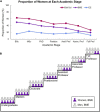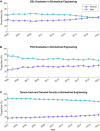Lifting as we climb: Experiences and recommendations from women in neural engineering
- PMID: 36968482
- PMCID: PMC10033556
- DOI: 10.3389/fnins.2023.1104419
Lifting as we climb: Experiences and recommendations from women in neural engineering
Abstract
Neural engineering is an emerging and multidisciplinary field in which engineering approaches are applied to neuroscience problems. Women are underrepresented in engineering fields, and indeed in science, technology, engineering, and mathematics (STEM) fields generally. Underrepresentation of women is particularly notable at later academic career stages, suggesting that even though women are interested in the field, barriers exist that ultimately cause them to leave. Here, we investigate many of the obstacles to women's success in the field of neural engineering and provide recommendations and materials to overcome them. We conducted a review of the literature from the past 15 years regarding the experiences of women in academic careers, as well as reports on the number of women in fields closely related to neural engineering from the National Science Foundation (NSF) and the American Society for Engineering Education (ASEE). Additionally, we interviewed six women in neural engineering who are involved in initiatives and outreach concerning the inclusion and experiences of women in engineering. Throughout the literature and interviews, we identified common themes spanning the role of identity and confidence, professional relationships, career-related hurdles, and personal and professional expectations. We explore each of these themes in detail and provide resources to support the growth of women as they climb within the field of neural engineering.
Keywords: STEM; academia; academic careers; bias; equity; gender representation; inclusion and diversity; neural engineering.
Copyright © 2023 Jantz, Mak, Dalrymple, Farooqui, Grigsby, Herrera, Pirondini and Collinger.
Conflict of interest statement
The authors declare that the research was conducted in the absence of any commercial or financial relationships that could be construed as a potential conflict of interest.
Figures



References
-
- Alemán A. (2017). “Generational Dispositions of Women Faculty: A Critical Examination,” in Critical approaches to women and gender in higher education, eds Eddy P., Ward K., Khwaja T. (New York, NY: Palgrave Macmillan US; ), 215–234.
-
- Arellano G., Jaime-Acuña O., Graeve O., Madsen L. (2018). Latino engineering faculty in the United States. MRS Bull. 43 131–147.
-
- American Society for Engineering Education [ASEE] (2021b). Engineering and engineering technology by the numbers 2020. Washington, DC: American Society for Engineering Education.
-
- American Society for Engineering Education [ASEE] (2021a). By the Numbers – IRA | ASEE. Washington, DC: American Society for Engineering Education. Available online at: https://ira.asee.org/by-the-numbers/
Publication types
LinkOut - more resources
Full Text Sources
Miscellaneous

